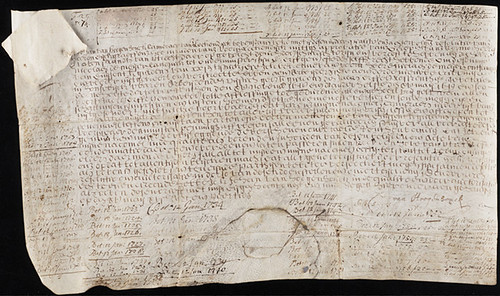
PREV ARTICLE
NEXT ARTICLE
FULL ISSUE
PREV FULL ISSUE
1648 PERPETUAL DUTCH BOND STILL PAYS INTERESTJohn Mellman passed along this interesting article from Yale Alumni Magazine about a 375-year-old Dutch bond that still pays interest. Thanks! -Editor
One of Yale's most intriguing investments is a 375-year-old Only about five such bonds are known to have survived from the Dutch Golden Age. Yale's was issued in 1648, the same month in which the Treaty of Munster ended the Eighty Years' War by recognizing the sovereignty of the Dutch Republic. The Lekdijk bond is a reminder that in the sixteenth and seventeenth centuries, the Dutch fought a war on two fronts: a war of independence from Spain and a battle against water.
The bond shows us exactly how the seventeenth-century Dutch were able to raise enough capital to build and maintain their remarkable system of dikes, canals, and polders (lands reclaimed from the water). In a sense, bonds like these made the modern Netherlands possible. A key financial innovation was the Hoogheemraadschap water companies. They were endowed with the extra-governmental power of taxation, and even the extraordinary right to mobilize citizens into The document is more than an interesting historical curio. The text reveals precisely the conditions under which the investors were willing to provide necessary capital. In the text, Johan van Hogenhouck, the Cameraer of Lekdijk Bovendams, promises to pay Niclaes de Meijer, the Canonick of Oudemunster, or his successors or assigns, 50 guilders per year in perpetuity in exchange for his 1,000-guilder capital contribution. Hogenhouck represented the company and its directors; de Meijer was the canon of one of Utrecht's oldest churches. Although the Oudemunster church is now gone, its handsome sixteenth-century Canonick's house is still standing. De Meijer appears to have bought the bond as a personal investment, and he likely regarded it as fairly safe. The five percent yield on the 1648 Lekdijk bond was similar to the yield on Dutch government securities at the time—suggesting that investors considered the promised payments of a Hoogheemraadschap to be as safe as those of the newly recognized nation. Written, signed, and sealed on vellum, the Lekdijk instrument was a thoughtfully designed tool meant to survive centuries. It functioned quite simply. The text makes clear that the bond was transferable, and payment was to be made to the bearer of the security, not to someone listed in a registry. Presented at the company offices, payment was made and then recorded directly in the margins or on the back of the instrument. Not surprisingly, the front and back are covered with records of annual interest payments that began in 1648 and continued to 1943, at which time a paper document, called an allonge, was created to continue the recording of interest payments. When Yale acquired the document in 2003 at auction, we learned that payments had to be collected in person. School of Management finance professor Geert Rouwenhorst picked up the bond and collected the unpaid interest due from 1977 to 2003. Beinecke curator Timothy Young presented the allonge in 2015 at the Stichtse Rijnlanden offices to collect the subsequent twelve years of payments. The latter amounted to the equivalent of $153. Inflation since 1648 had taken its toll—as did a seventeenth-century reduction in the interest rate by half. Writing the receipt for payment right on the document was a clever way to ensure that the bondholder could not claim they had not been paid. The text also explains precisely what the borrowed money would be used for: to pay workers to repair the new cribbing on a curve of the Lek river near the town of Honswijk, part of a five-mile stretch of dike just outside the city of Utrecht. Cribbing is a system of piers that extends into the river current and is designed to prevent erosion. Though the town of Honswijk has mostly disappeared, the dike holding back the Lek and the cribbing protecting it are plainly visible in Google Earth. Not only does Stichtse Rijnlanden continue to honor the terms of the promise made to Niclaes de Meijer in 1648, but it also maintains the same Lek cribbing at the Honswijk dike. The water company has repaired and likely refinanced the cribbing regularly through the centuries.
To read the complete article, see:
Wayne Homren, Editor The Numismatic Bibliomania Society is a non-profit organization promoting numismatic literature. See our web site at coinbooks.org. To submit items for publication in The E-Sylum, write to the Editor at this address: whomren@gmail.com To subscribe go to: https://my.binhost.com/lists/listinfo/esylum All Rights Reserved. NBS Home Page Contact the NBS webmaster 
|

